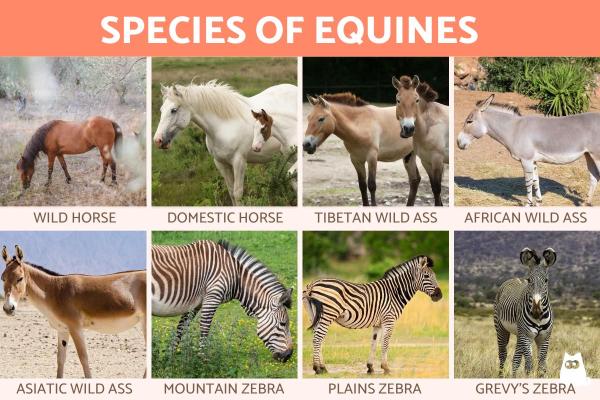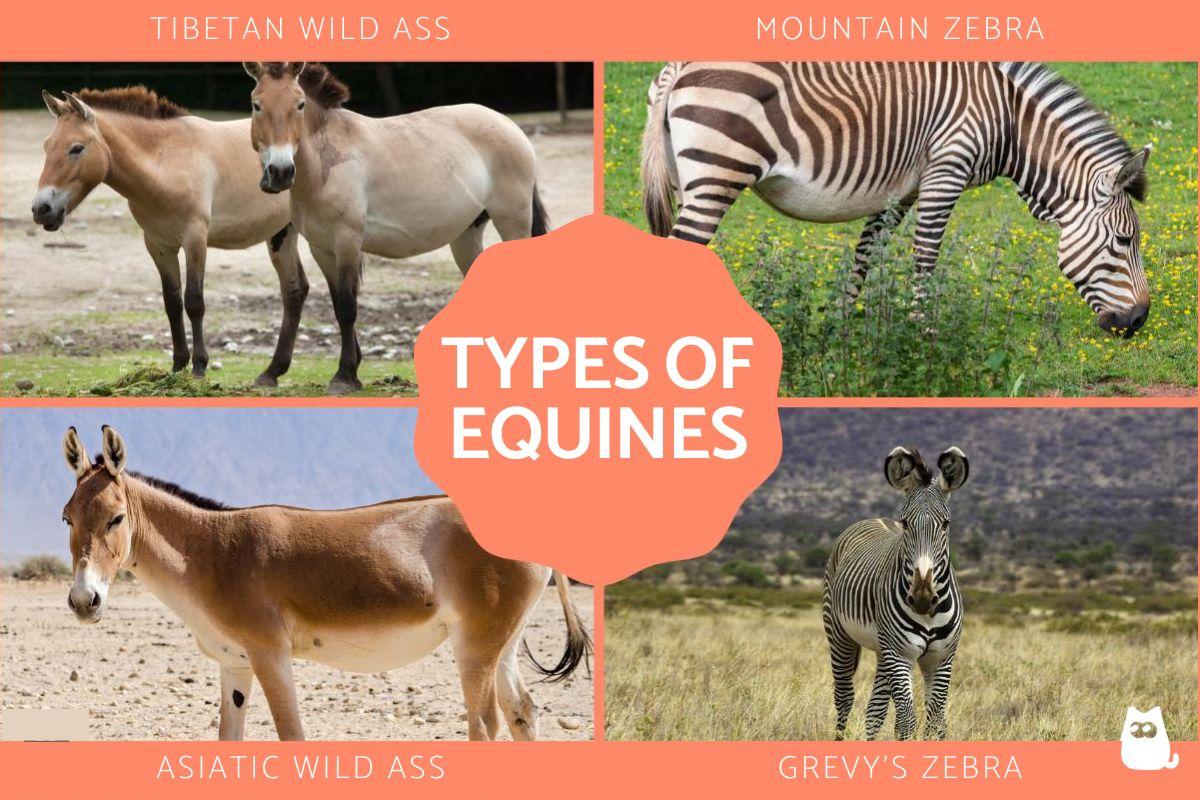What Are Equines? - Types and Characteristics



See files for Horses
Equines are a fascinating and diverse group of mammals that have played a significant role in human history and continue to do so today. From the majestic horses used for transportation, sport, and work, to the hardy donkeys and mules used for farming and packing, equines have been an essential part of human societies for thousands of years.
In the following AnimalWised article, what are equines, their characteristics, classification, and historical significance. We will also delve into some of the most interesting and surprising facts about these amazing animals.
What are equines?
Equines are a group of mammals that belong to the family Equidae. Equines are known for their slender legs, hooves, and long faces with large, expressive eyes. They are herbivores, feeding primarily on grasses and other vegetation.
The origin of equines can be traced back to the Eocene epoch, which began about 56 million years ago. During this time, the first ancestral horses, known as Hyracotherium or Eohippus, appeared in what is now North America. These early equids were small, about the size of a small dog, and had four toes on their front feet and three toes on their hind feet.
Over millions of years, the equids gradually evolved into larger and more specialized forms. One of the most significant changes was the development of a single hoof on each foot, which allowed them to run faster and with greater endurance. By the end of the Miocene epoch, about 5 million years ago, equids had spread to other continents, including Asia and Europe.
Today, there are several species of equines, including horses, donkeys, and zebras, which have all evolved to fill different ecological niches and serve different purposes in human societies.
Do not miss this other article, where we explain what are wild horses.
Physical characteristics of equines
Equines have a set of distinctive physical and behavioral characteristics that are typical of their group. Let us take a closer look at their common physical features:
- Equines have hooves, which are hard and keratinized structures that cover the ends of their toes. Hooves are essential for support and movement on various surfaces.
- Equines have long faces and large, expressive eyes that give them a distinctive appearance. This facial structure is adapted to help them graze on vegetation and spot predators.
- Equines have slender legs that are adapted for running and jumping. Their legs are supported by tendons and ligaments that act like springs, which helps them conserve energy while moving.
- Equines have between 40 and 42 teeth and can weigh between 200 and 500 kg in the wild, while domesticated ones range from about 140 to 1000 kg.
- Equines have a thick skin that is covered in a coat of hair or fur, which varies in color and texture among different species.
- Equines have a unique digestive system, which is adapted to a herbivorous diet. They have a complex system of intestines and an enlarged cecum that allows them to break down tough plant matter and extract nutrients efficiently.
Equines are renowned for their remarkable speed and endurance, owing to their unique physical features. Horses, in particular, are considered one of the swiftest land animals, with the ability to run at impressive speeds of up to 70 km/h (43 mph).
Equines do not only share common physical characteristics, but they also exhibit similar behavior patterns.
You might be interested in this other article, where we explain what do zebras eat.

Behavior patterns of equines
Equines are social animals and usually live in groups or herds. They form strong bonds with their herd members and communicate with each other through a range of vocalizations, body language, and scent cues. Equines also engage in playful behavior, particularly when they are young. They can be seen running, kicking, bucking, and frolicking in the fields as a way of expending energy and developing physical coordination.
Now, let's explore in more detail the various behavioral traits that these fascinating animals have in common:
- Equines are known for their strong flight response, which means they are quick to flee when they perceive a threat. They have evolved this response as a survival mechanism to evade predators in the wild.
- Equines establish a social hierarchy within their herd, where each member has a specific rank and role. This hierarchy is established through aggressive displays and physical interactions such as biting, kicking, and pushing.
- Equines are strictly herbivorous and spend a considerable amount of their day grazing on grass or other vegetation. They have evolved specialized teeth and digestive systems to efficiently break down and extract nutrients from tough plant matter.
- Equines can sleep standing up, which is a unique adaptation that allows them to rest and stay alert at the same time. They can also lay down to sleep, but usually only do so for short periods.
- Equines are polygamous animals, meaning they can have multiple mates throughout their lives.
- Equines are viviparous animals, meaning they give birth to live young that develop inside the mother's womb. Generally, equines give birth to a single offspring per gestation, although there have been rare cases of twins or even triplets. Although equines can have multiple heats a year, they generally breed every two years.
You might also be interested in this other article, where we explain how long does a horse live.

Species of equines
There are currently seven extant (living) species of equines in the family Equidae. They are:
- Domestic horse (Equus ferus): refers to the wild horse species that originated in Eurasia and served as the ancestor of the modern-day domestic horse. They were an essential source of transportation, food, and cultural significance for humans throughout history. Today, wild horse populations are limited and can be found in protected areas.
- African wild ass (Equus africanus): this species is native to the Horn of Africa, particularly Somalia, Ethiopia, and Eritrea. They are adapted to living in arid and desert areas and can survive without water for long periods.
- Asiatic wild ass (Equus hemionus): this species is native to arid and desert areas of Central Asia, including parts of Mongolia, China, Iran, and Pakistan. They are well adapted to harsh desert environments and can survive without water for long periods.
- Tibetan wild ass (Equus kiang): this species is native to the Tibetan Plateau and surrounding areas, including parts of China, India, Nepal, and Bhutan. They live in high-altitude grasslands and can survive in cold and harsh environments. Kiangs are the largest of the wild asses and are well adapted for running at high speeds.
- Grevy's zebra (Equus grevy): this species is native to arid areas of Kenya and Ethiopia and is the largest of the three zebra species. They have distinct narrow stripes and a white belly.
- Plains zebra (Equus quagga): this species is native to grasslands and savannas of Africa and is characterized by its black and white striped coat. Plains zebras are social animals and often form large herds. They play an important role in their ecosystem as grazers, helping to maintain the balance of vegetation in their habitat.
- Mountain zebra (Equus zebra): is a species of zebra native to Southern Africa, particularly in Angola, Namibia, and South Africa. They are characterized by their unique stripe patterns, with a dewlap on the throat and a white belly. Mountain zebras live in mountainous habitats and are well-adapted to harsh and arid environments.
Be sure to check out our other article where we explore the differences between a donkey, a mule, and an ass.

Historical significance of equines
Equines, including horses and donkeys, have played a significant role in human history. Domesticated horses were first used for transportation and agricultural work around 4000 BC, while donkeys were domesticated shortly thereafter. Both horses and donkeys have been crucial to the development of human civilization.
Horses have been used for a wide range of purposes throughout history, including transportation, agriculture, warfare, and trade. They have provided humans with the ability to travel long distances quickly and efficiently, and have been used to transport goods and people across vast distances.
Horses have also been used in warfare throughout history, providing soldiers with a faster and more mobile means of transportation and allowing for more effective cavalry charges. The use of horses has also had a significant impact on trade and commerce, facilitating the transportation of goods and people across long distances.
Donkeys, on the other hand, have been valued for their hard work and reliability. They are well-suited for working in arid and mountainous regions, and were often used to carry goods and supplies across difficult terrain. Donkeys have also been used as pack animals by armies, as they are able to carry heavy loads over long distances.
In addition to their practical uses, both horses and donkeys have also held cultural and symbolic significance in many societies. They have been featured in art, literature, and mythology for thousands of years and have been associated with nobility, power, and freedom.
Both horses and donkeys continue to play important roles in various industries and cultural practices. They are used for transportation, agriculture, and recreation, and are also used in therapy programs for people with disabilities.
If you want to read similar articles to What Are Equines? - Types and Characteristics, we recommend you visit our Facts about the animal kingdom category.
- Ballenger, L.; P. Myers (2001). Equidae . Animal Diversity Web. Available at: https://animaldiversity.org/accounts/Equidae/
- Britannica (2020). equine . Britannica Encyclopedia. Available in: https://www.britannica.com/animal/equine. Accessed March 16, 2023.
- IUCN (2022). The IUCN Red List of Threatened Species . Version 2022-1. Available at: https://www.iucnredlist.org








